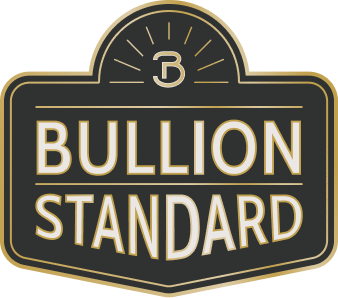The Effect of Government Regulations on Bullion Trading
By Bullion Standard ·
6 min read
Government regulations play a massive role in shaping the gold market—often in ways that aren’t immediately obvious.
From taxes and tariffs to central bank policies, these rules can make or break the ease and profitability of trading gold bullion.
At Bullion Standard, we empower investors with the knowledge and tools to navigate gold markets. This post breaks down the effect of government actions on bullion trading, offering practical knowledge to help investors stay ahead.
Why Government Regulations Matter in Bullion Trading
Gold and silver are a part of a dynamic and active market—and government regulations play a huge role in how they’re traded.
Government regulations, such as tariffs or sanctions, not only affect the current gold market but also influence gold futures prices (the agreed-upon price for the future delivery of gold).
Given that gold prices tend to fluctuate in response to government decisions, understanding these regulations is essential for potential investors.
Who Controls the Price of Gold?
When it comes to bullion trading, who controls the price of gold? Well, it's influenced by a combination of factors, with no single entity having absolute control. Gold price movements are primarily driven by:
- Market forces like supply and demand
- The London Bullion Market Association, which sets daily gold price benchmarks
- Global economic conditions like inflation, currency values, and geopolitical events
Government regulations—such as tariffs and taxes—also play a major part in influencing how gold is priced and traded on the global stage. Let's take a closer look at how:

8 Ways Government Regulations Can Influence Gold Prices
1. Tariffs on Bullion Imports
One way governments can influence bullion trading is through tariffs on gold and silver imports.
Countries like India, which has high demand for gold, often impose tariffs to protect their currency and control inflation. These tariffs can drive up the price of bullion in the domestic market, impacting both traders and investors.
2. Tax Policies and Their Effects
Tax policies play a significant role in shaping the profitability of bullion investments. In many countries, including the United States, profits from gold and silver sales are subject to capital gains taxes.
This means that if you sell bullion for more than you originally paid, the profit is treated as taxable income. The rate can vary based on how long you’ve held the asset, with short-term gains often taxed at higher rates than long-term gains.
3. International Trade Agreements
Another aspect of government regulation that impacts bullion trading is international trade agreements.
Countries that are part of trade agreements may have lower tariffs and fewer restrictions on importing and exporting bullion. This can create more opportunities for traders and investors to access bullion at lower prices.
4. Environmental Regulations
Environmental regulations have a substantial impact on the worldwide gold mining industry, as mining companies must adhere to strict environmental standards.
These regulations aim to minimize the ecological damage caused by gold and silver extraction, but they also lead to higher operational costs for mining companies. These increased costs are typically passed on to investors, resulting in higher gold and silver prices.
5. Anti-Money Laundering Laws
Governments around the world have implemented anti-money laundering (AML) laws to prevent illegal activities in financial markets, including bullion trading.
These laws require bullion dealers and traders to follow strict reporting and compliance procedures, which can make trading more complex and costly.
6. Inflation
Inflation is another factor that government policies can affect, which in turn influences how often investors buy and sell gold.
When inflation rises, the purchasing power of currency decreases, making bullion a more attractive investment. Government decisions related to interest rates and money supply can have a direct impact on inflation and, consequently, on gold demand.
7. Trade Sanctions and Bullion Markets
Trade sanctions can also affect bullion trading. For example, if a country is subject to international sanctions, it may face restrictions on importing or exporting gold. This can create supply shortages and increase the price of bullion in affected markets.
Additionally, sanctions can force countries to seek alternative trading partners or channels, often increasing transaction costs, which further impacts the overall price of bullion.
8. Central Bank Policies
Central banks have the power to influence gold prices through their monetary policies.
By adjusting interest rates or engaging in quantitative easing, central banks can affect inflation, currency values, and investor confidence, all of which play a role in determining gold prices. Many investors closely watch central bank actions to predict movements in the bullion market.
Real Examples of Government Influence
The 1933 Gold Confiscation
One significant example of government regulation on the bullion market occurred in 1933 when President Franklin D. Roosevelt signed Executive Order 6102, which prohibited U.S. citizens from hoarding gold.
This law required individuals to sell their gold to the government at a fixed price of $20.67 per ounce, well below market value.
The order aimed to stabilize the U.S. economy during the Great Depression by increasing the gold reserves held by the government, but it also significantly impacted private ownership and trading.
India’s Fluctuating Gold Import Tariffs
India offers a modern example of how government regulation affects bullion trading. To manage its trade deficit and reduce domestic gold consumption, India has regularly adjusted its tariffs on gold imports.
These tariffs make it more expensive to bring gold into the country, limiting supply and driving up prices in the domestic market.
As the world’s second-largest consumer of gold, India’s tariff policy shifts can have ripple effects on the global bullion market, influencing demand and pricing worldwide.
How Can Investors Navigate These Regulations?
Navigating government regulations in the bullion market might seem complicated, but staying informed can keep you on track.
To start, keep up with central bank actions and global economic trends, as these factors can affect both short- and long-term gold prices. It’s also wise to diversify your portfolio, as this can provide a safety net if sudden regulatory changes impact the gold market.
Finally, consider working with a trusted bullion dealer who can provide up-to-date market insights and help you make informed investment decisions in response to regulatory shifts.

Key Takeaways for Bullion Investors
When it comes to who controls the price of gold, the answer isn't straightforward. One major player, however, are government regulations. These can shape the gold market significantly, affecting prices and trading opportunities.
By understanding how these regulations work and staying informed about changes in policies, you can better navigate the oftentimes confusing world of bullion trading.
Bullion Standard is here to help you invest with confidence. Our mission is to provide transparent pricing and expert advice, so you can make investment decisions that you align with. Ready to get started? Check out our resources or shop online to start protecting your future today.






















